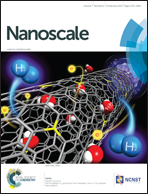Bipyridine hydrogel for selective and visible detection and absorption of Cd2+†
Abstract
Herein, we report for the first time the use of bipyridine-based hydrogel for selective and visible detection and absorption of Cd2+. At low concentrations, hydrogelator 1 was applied for selective detection of Cd2+in vitro and in living cells with high sensitivity. In the absence of metal ions, 1 is nonfluorescent at 470 nm. Upon addition of metal ions, 1 selectively coordinates to Cd2+, causing an 86-fold increase of fluorescence intensity at 470 nm via the chelation enhanced fluorescence (CHEF) effect, as revealed by first-principles simulations. At 1.5 wt% and pH 5.5, 1 self-assembles into nanofibers to form hydrogel Gel I. Since Cd2+ could actively participate in the hydrogelation and promote the self-assembly, we also successfully applied Gel I for visible detection and absorption of Cd2+. With these excellent properties, Gel I is expected to be explored as one type of versatile biomaterial for not only environmental monitoring but also for pollution treatment in the near future.


 Please wait while we load your content...
Please wait while we load your content...